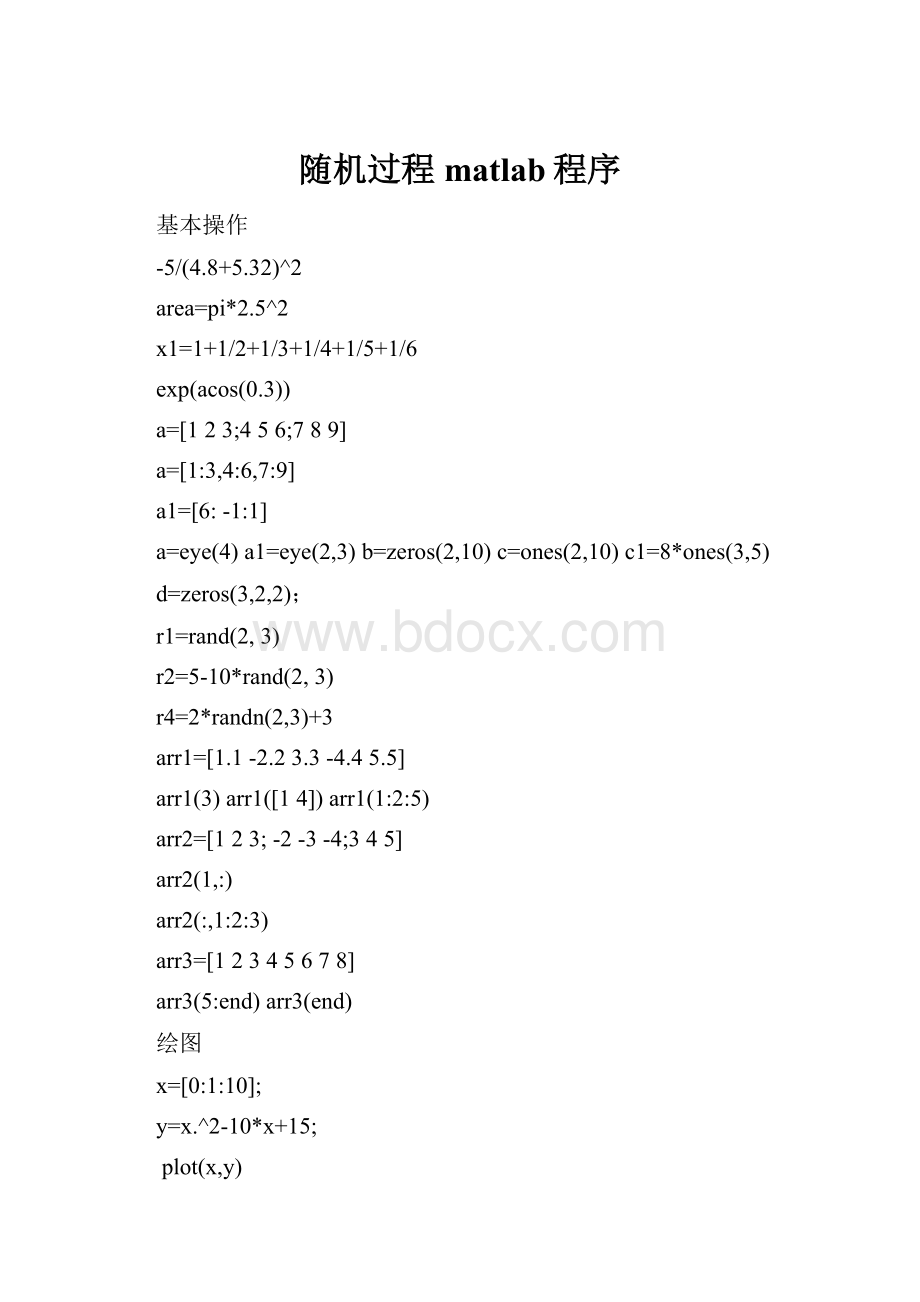随机过程matlab程序.docx
《随机过程matlab程序.docx》由会员分享,可在线阅读,更多相关《随机过程matlab程序.docx(29页珍藏版)》请在冰豆网上搜索。

随机过程matlab程序
基本操作
-5/(4.8+5.32)^2
area=pi*2.5^2
x1=1+1/2+1/3+1/4+1/5+1/6
exp(acos(0.3))
a=[123;456;789]
a=[1:
3,4:
6,7:
9]
a1=[6:
-1:
1]
a=eye(4)a1=eye(2,3)b=zeros(2,10)c=ones(2,10)c1=8*ones(3,5)
d=zeros(3,2,2);
r1=rand(2,3)
r2=5-10*rand(2,3)
r4=2*randn(2,3)+3
arr1=[1.1-2.23.3-4.45.5]
arr1(3)arr1([14])arr1(1:
2:
5)
arr2=[123;-2-3-4;345]
arr2(1,:
)
arr2(:
1:
2:
3)
arr3=[12345678]
arr3(5:
end)arr3(end)
绘图
x=[0:
1:
10];
y=x.^2-10*x+15;
plot(x,y)
x=0:
pi/20:
2*pi
y1=sin(x);y2=cos(x);
plot(x,y1,'b-');
holdon;
plot(x,y2,‘k--’);
legend(‘sinx’,‘cosx’);
x=0:
pi/20:
2*pi;
y=sin(x);
figure
(1)
plot(x,y,'r-')
gridon
以二元函数图z=xexp(-x^2-y^2)为例讲解基本操作,首先需要利用meshgrid函数生成X-Y平面的网格数据,如下所示:
xa=-2:
0.2:
2;
ya=xa;
[x,y]=meshgrid(xa,ya);
z=x.*exp(-x.^2-y.^2);
mesh(x,y,z);
建立M文件
functionfenshu(grade)
ifgrade>95.0
disp('ThegradeisA.');
else
ifgrade>86.0
disp('ThegradeisB.');
else
ifgrade>76.0
disp('ThegradeisC.');
else
ifgrade>66.0
disp('ThegradeisD.');
else
disp('ThegradeisF.');
end
end
end
end
end
functiony=func(x)
ifabs(x)<1
y=sqrt(1-x^2);
elsey=x^2-1;
end
functionsumm(n)
i=1;
sum=0;
while(i<=n)
sum=sum+i;
i=i+1;
end
str=['¼ÆËã½á¹ûΪ£º',num2str(sum)];
disp(str)
end
求极限
symsx
limit((1+x)^(1/x),x,0,'right')
求导数
symsx;
f=(sin(x)/x);
diff(f)
diff(log(sin(x)))
求积分
symsx;
int(x^2*log(x))
symsx;
int(abs(x-1),0,2)
常微分方程求解
dsolve('Dy+2*x*y=x*exp(-x^2)','x')
计算偏导数
x/(x^2+y^2+z^2)^(1/2)
diff((x^2+y^2+z^2)^(1/2),x,2)
重积分
int(int(x*y,y,2*x,x^2+1),x,0,1)
级数
symsn;
symsum(1/2^n,1,inf)
Taylor展开式
求y=exp(x)在x=0处的5阶Taylor展开式
taylor(exp(x),0,6)
矩阵求逆
A=[0-6-1;62-16;-520-10]
det(A)
inv(A)
特征值、特征向量和特征多项式
A=[0-6-1;62-16;-520-10];
lambda=eig(A)
[v,d]=eig(A)
poly(A)
多项式的根与计算
p=[10-2-5];
r=roots(p)
p2=poly(r)
y1=polyval(p,4)
例子:
x=[-3:
3]'
y=[3.03,3.90,4.35,4.50,4.40,4.02,3.26]';
A=[2*x,2*y,ones(size(x))];
B=x.^2+y.^2;
c=inv(A'*A)*A'*B;
r=sqrt(c(3)+c
(1)^2+c
(2)^2)
例子
ezplot('-2/3*exp(-t)+5/3*exp(2*t)','-2/3*exp(-t)+2/3*exp(2*t)',[0,1])
gridon;axis([0,12,0,5])
密度函数和概率分布
设x~b(20,0.1),
binopdf(2,20,0.1)
分布函数
设x~N(1100,502),y~N(1150,802),则有
normcdf(1000,1100,50)=0.0228,1-0.0228=0.9772
normcdf(1000,1150,80)=0.0304,1-0.0304=0.9696
统计量数字特征
x=[29.827.628.3]
mean(x)
max(x)
min(x)
std(x)
symspk;
Ex=symsum(k*p*(1-p)^(k-1),k,1,inf)
symsxy;
f=x+y;
Ex=int(int(x*y*f,y,0,1),0,1)
参数估计
例:
对某型号的20辆汽车记录其5L汽油的行驶里程(公里),
观测数据如下:
29.8 27.6 28.3 27.9 30.1 28.7 29.9 28.0 27.9 28.7
28.4 27.2 29.5 28.5 28.0 30.0 29.1 29.8 29.6 26.9
设行驶里程服从正态分布,试用最大似然估计法求总体的均值和方差。
x1=[29.827.628.327.930.128.729.928.027.928.7];
x2=[28.427.229.528.528.030.029.129.829.626.9];
x=[x1x2]';
p=mle('norm',x);
muhatmle=p
(1),
sigma2hatmle=p
(2)^2
[m,s,mci,sci]=normfit(x,0.5)
假设检验
例:
下面列出的是某工厂随机选取的20只零部件的装配时间(分):
9.810.410.69.69.79.910.911.19.610.2
10.39.69.911.210.69.810.510.110.59.7
设装配时间总体服从正态分布,标准差为0.4,是否认定装配时间的均值在0.05的水平下不小于10。
解:
:
在正态总体的方差已知时MATLAB均值检验程序:
x1=[9.810.410.69.69.79.910.911.19.610.2];
x2=[10.39.69.911.210.69.810.510.110.59.7];
x=[x1x2]';m=10;sigma=0.4;a=0.05;[h,sig,muci]=ztest(x,m,sigma,a,1)
得到:
h=1,sig=0.01267365933873,muci=10.05287981908398Inf
%PPT例2一维正态密度与二维正态密度
symsxy;
s=1;t=2;
mu1=0;mu2=0;sigma1=sqrt((s^2));sigma2=sqrt((t^2));
x=-6:
0.1:
6;
f1=1/sqrt(2*pi*sigma1)*exp(-(x-mu1).^2/(2*sigma1^2));
f2=1/sqrt(2*pi*sigma2)*exp(-(x-mu2).^2/(2*sigma2^2));
plot(x,f1,'r-',x,f2,'k-.')
rho=(1+s*t)/(sigma1*sigma2);
f=1/(2*pi*sigma1*sigma2*sqrt(1-rho^2))*exp(-1/(2*(1-rho^2))*((x-mu1)^2/sigma1^2-2*rho*(x-mu1)*(y-mu2)/(sigma1*sigma2)+(y-mu2)^2/sigma2^2));
ezsurf(f)
%P34例3.1.1
p1=poisscdf(5,10)
p2=poisspdf(0,10)
[p1,p2]
%输出
p1=0.0671
p2=4.5400e-005
ans=0.06710.0000
%P40例3.2.1
p3=poisspdf(9,12)
%输出
p3=0.0874
%P40例3.2.2
p4=poisspdf(0,12)
%输出
p4=6.1442e-006
%P35-37(Th3.1.1)解微分方程
%输入:
symsp0p1p2;
S=dsolve('Dp0=-lamda*p0','Dp1=-lamda*p1+lamda*p0','Dp2=-lamda*p2+lamda*p1',
'p0(0)=1','p1(0)=0','p2(0)=0');
[S.p0,S.p1,S.p2]
%输出:
ans=
[exp(-lamda*t),exp(-lamda*t)*t*lamda,1/2*exp(-lamda*t)*t^2*lamda^2]
%P40泊松过程仿真
%simulate10times
clear;
m=10;lamda=1;x=[];
fori=1:
m
s=exprnd(lamda,'seed',1);
%seed是用来控制生成随机数的种子,使得生成随机数的个数是一样的.
x=[x,exprnd(lamda)];
t1=cumsum(x);
end
[x',t1']
%输出:
ans=
0.65090.6509
2.40613.0570
0.10023.1572
0.12293.2800
0.82334.1033
0.24634.3496
1.90746.2570
0.47836.7353
1.34478.0800
0.80828.8882
%输入:
N=[];
fort=0:
0.1:
(t1(m)+1)
ift(1)
N=[N,0];
elseift(2)
N=[N,1];
elseiftN=[N,2];
elseiftN=[N,3];
elseiftN=[N,4];
elseiftN=[N,5];
elseiftN=[N,6];
elseiftN=[N,7];
elseiftN=[N,8];
elseiftN=[N,9];
else
N=[N,10];
end
end
plot(0:
0.1:
(t1(m)+1),N,'r-')
%输出:
%simulate100times
clear;
m=100;lamda=1;x=[];
fori=1:
m
s=rand('seed');
x=[x,exprnd(lamda)];
t1=cumsum(x);
end
[x',t1']
N=[];
fort=0:
0.1:
(t1(m)+1)
ift(1)
N=[N,0];
end
fori=1:
(m-1)
ift>=t1(i)&tN=[N,i];
end
end
ift>t1(m)
N=[N,m];
end
end
plot(0:
0.1:
(t1(m)+1),N,'r-')
%输出:
%P48非齐次泊松过程仿真
%simulate10times
clear;
m=10;lamda=1;x=[];
fori=1:
m
s=rand('seed');%exprnd(lamda,'seed',1);setseeds
x=[x,exprnd(lamda)];
t1=cumsum(x);
end
[x',t1']
N=[];T=[];
fort=0:
0.1:
(t1(m)+1)
T=[T,t.^3];%timeisadjusted,cumulativeintensityfunctionist^3.
ift(1)
N=[N,0];
end
fori=1:
(m-1)
ift>=t1(i)&tN=[N,i];
end
end
ift>t1(m)
N=[N,m];
end
end
plot(T,N,'r-')
%output
ans=
0.42200.4220
3.33233.7543
0.16353.9178
0.06833.9861
0.38754.3736
0.27744.6510
0.29694.9479
0.93595.8838
0.42246.3062
1.76508.0712
10timessimulation100timessimulation
%P50复合泊松过程仿真
%simulate100times
clear;
niter=100;%iteratenumber
lamda=1;%arrivingrate
t=input('Inputatime:
','s')
fori=1:
niter
rand('state',sum(clock));
x=exprnd(lamda);%intervaltime
t1=x;
whilet1x=[x,exprnd(lamda)];
t1=sum(x);%arrivingtime
end
t1=cumsum(x);
y=trnd(4,1,length(t1));%rand(1,length(t1));gamrnd(1,1/2,1,length(t1)));frnd(2,10,1,length(t1)));
t2=cumsum(y);
end
[x',t1',y',t2']
X=[];m=length(t1);
fort=0:
0.1:
(t1(m)+1)
ift(1)
X=[X,0];
end
fori=1:
(m-1)
ift>=t1(i)&tX=[X,t2(i)];
end
end
ift>t1(m)
X=[X,t2(m)];
end
end
plot(0:
0.1:
(t1(m)+1),X,'r-')
跳跃度服从[0,1]均匀分布情形跳跃度服从
分布情形
跳跃度服从t(10)分布情形
%%Simulatetheprobabilitythatsalesrevenuefallsinsomeinterval.(e.g.example3.3.6inteachingmaterial)
clear;
niter=1.0E4;%numberofiterations
lamda=6;%arrivingrate(unit:
minute)
t=720;%12hours=720minutes
above=repmat(0,1,niter);%setupstorage
fori=1:
niter
rand('state',sum(clock));
x=exprnd(lamda);%intervaltime
n=1;
whilexx=x+exprnd(1/lamda);%arrivingtime
ifx>=t
n=n;
else
n=n+1;
end
end
z=binornd(200,0.5,1,n);%generatensales
y=sum(z);
above(i)=sum(y>432000);
end
pro=mean(above)
Output:
pro=0.3192
%%Simulatethelosspro.ForaCompoundPoissonprocess
clear;
niter=1.0E3;%numberofiterations
lamda=1;%arrivingrate
t=input('Inputatime:
','s')
below=repmat(0,1,niter);%setupstorage
fori=1:
niter
rand('state',sum(clock));
x=exprnd(lamda);%intervaltime
n=1;
whilexx=x+exprnd(lamda);%arrivingtime
ifx>=t
n=n;
else
n=n+1;
end
end
r=normrnd(0.05/253,0.23/sqrt(253),1,n);%generatenrandomjumps
y=log(1.0E6)+cumsum(r);
minX=min(y);%minmumreturnovernextnjumps
below(i)=sum(minXend
pro=mean(below)
Output:
t=50,pro=0.45
%P75(Example5.1.5)马氏链
chushivec0=[001000]
P=[0,1/2,1/2,0,0,0;1/2,0,1/2,0,0,0;1/4,1/4,0,1/4,1/4,0;0,0,1,0,0,0,;0,0,1/2,0,0,1/2;0,0,0,0,1,0]
jueduivec1=chushivec0*P
jueduivec2=chushivec0*(P^2)
%计算1到n步后的分布
chushivec0=[001000];
P=[0,1/2,1/2,0,0,0;1/2,0,1/2,0,0,0;1/4,1/4,0,1/4,1/4,0;0,0,1,0,0,0,;0,0,1/2,0,0,1/2;0,0,0,0,1,0];
n=10
t=1/6*ones([16]);
jueduivec=repmat(t,[n1]);
fork=1:
n
jueduiveck=chushivec0*(P^k);
jueduivec(k,1:
6)=jueduiveck
end
%比较相邻的两行
n=70;
jueduivecn=chushivec0*(P^n)
n=71;
jueduivecn=chushivec0*(P^n)
%Replacethefirstdistribution,Comparingtwoneighbourabsolute-vectorsoncemore
chushivec0=[1/61/61/61/61/61/6];
P=[0,1/2,1/2,0,0,0;1/2,0,1/2,0,0,0;1/4,1/4,0,1/4,1/4,0;0,0,1,0,0,0,;0,0,1/2,0,0,1/2;0,0,0,0,1,0];
n=70;
jueduivecn=chushivec0*(P^n)
n=71;
jueduivecn=chushivec0*(P^n)
%赌博问题模拟(带吸收壁的随机游走:
结束1次游走所花的时间及终止状态)
a=5;p=1/2;
m=0;
whilem<100
m=m+1;
r=2*binornd(1,p)-1;
ifr==-1
a=a-1;
else
a=a+1;
end
ifa==0|a==10
break;
end
end
[ma]
%赌博问题模拟(带吸收壁的随机游走:
结束N次游走所花的平均时间及终止状态分布规律)
%p=q=1/2
p=1/2;
m1=0;m2=0;N=1000;
t1=0;t2=0;
forn=1:
1:
N
m=0;a=5;
whilea>0&a<10
m=m+1;
r=2*binornd(1,p)-1;
ifr==-1
a=a-1;
else
a=a+1;
end
end
ifa==0
t1=t1+m;m1=m1+1;
else
t2=t2+m;m2=m2+1;
end
end
fprintf('Theaveragetimesofarriving0and10respectivelyare%d,%d.\n',[t1/m1,t2/m2]);
fprintf('Thefrequenciesofarriving0and10respectivelyare%d,%d.\n',[m1/N,m2/N]);
%verify:
fprintf('Theprobabilityofarriving0anditsapproximaterespectivelyare%d,%d.\n',[5/10,m1/N]);
fprintf('Theexpectationofarriving0or10anditsapproximaterespectivelyare%d,%d.\n',[5*(10-5)/(2*p),(t1+t2)/N]);
%p~=q
p=1/4;
m1=0;m2=0;N=1000;
t1=zeros(1,N);t2=zeros(1,N);
forn=1:
1:
N
m=0;a=5;
whilea>0&a<15
m=m+1;
r=2*binornd(1,p)-1;
ifr==-1
a